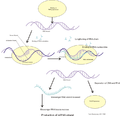What is mRNA and what makes it a good treatment option?
Messenger RNA (mRNA) sends signals to the cells to make certain proteins by changing the genetic coding. So mRNA has the potential to treat a variety of diseases because it can induce cells to make therapeutic proteins. This essentially makes the patient’s body cells into a treatment factory which would give patients a less invasive treatment option.
One of the obstacles with this treatment is how to deliver mRNA to the diseased area safely and efficiently. Researchers at MIT have found a new way to provide patients with mRNA. They made an inhalable form of mRNA. The goal would be to administer the mRNA similar to an asthma inhaler where powered mRNA medication would be sprayed into the lungs but as of now, the medication is only available in nebulizer form. However, there needed to be a way to stabilize the mRNA molecules using an aerosol method. So the researchers experimented with positively charged beta-amino esters which are biodegradable and are more easily broken down by the body. The upside to using a biodegradable material is that there would be a minimal accumulation of the substance in the area it was administered. Accumulation would cause unwanted side effects to the patients’ health.
To test out their new product MIT scientists put the mRNA molecule and polymers in spheres. Then suspended those spheres in water droplets and distributed a mist through a nebulizer to mice. But the mRNA molecules that they put into the spheres coded for the production of the bioluminescent protein luciferase. Using the code for the bioluminescent luciferase, the researchers would be able to see if the mRNA had effectively made the protein that it coded for if it glowed.
After 24 hours since administering the medication, the mice were producing bioluminescent proteins in their lungs which hints that eventually scientists could inject the code for therapeutic proteins in the mRNA and the cells would respond. But as the mRNA levels dropped so did the protein production. That showed that only with repeated doses of the medication the mice would be able to continuously produce their own proteins. They also found that mRNA was evenly distributed throughout the five lobes of the lungs so the mRNA reached all the areas of the lungs which would be helpful in treating cystic fibrosis. This process could be the future treatments for chronic lung diseases as researchers work to make this product into inhaler form instead of the nebulizer for convenience purposes.



Leave a Reply